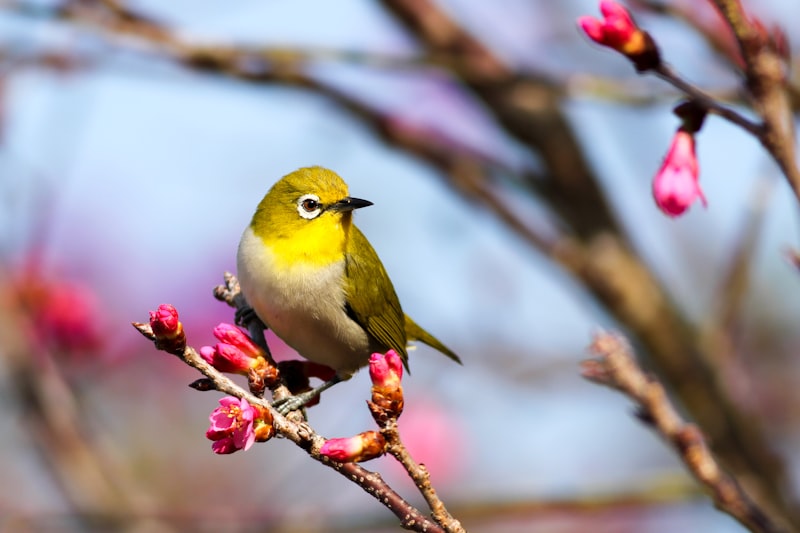Imagine a male bird, vibrant in plumage, serenading potential mates with a melodious song echoing through the forest. His plumage isn’t just for show; it’s a visual symphony designed to captivate the eyes of discerning females. In the realm of neuroethology, this display is more than mere courtship—it’s a finely tuned behavior shaped by millions of years of evolution.
Neuroethology, the study of how the nervous system shapes animal behavior, reveals that mate choice in birds is governed by a complex interplay of sensory cues and neural responses. For instance, the vibrant colors of a male bird’s feathers aren’t merely decorative; they signal genetic fitness and health to potential mates. This biological billboard broadcasts information about the bird’s ability to thrive and survive in its environment.
Furthermore, the neurobiology behind mate choice extends beyond physical appearance. Birds often engage in elaborate courtship rituals that involve precise movements and vocalizations. These behaviors aren’t just instinctual; they’re orchestrated by neural circuits that have evolved to ensure successful reproduction.
Consider the analogy of a theater production where each bird plays a role scripted by millions of years of evolutionary theater. From the subtle nuances of a mating dance to the intricate harmonies of a song, every gesture and note is a part of a larger narrative written by the forces of natural selection.
Unlocking the Secrets: How Bird Brains Navigate Mate Choice
In the avian world, mate selection is not just a random process but a critical determinant of reproductive success. Birds employ various strategies to attract and choose their mates, each species uniquely adapted to its environment and social structure. From colorful plumage to elaborate courtship dances, these displays serve as signals of fitness and genetic quality.
Take the peacock, for example, whose elaborate tail feathers are a testament to its health and vigor. Female peahens are known to prefer males with more extravagant plumage, as it signifies their ability to survive and thrive in their habitat. This preference is not merely superficial; it’s deeply ingrained in their genetic makeup, ensuring that their offspring inherit advantageous traits.
Moreover, environmental factors play a crucial role in mate choice among birds. Songbirds, renowned for their melodious calls, use their vocal prowess to attract potential mates. The complexity and consistency of their songs often indicate genetic fitness and the ability to defend territories, making them highly desirable partners.
In addition to physical traits and vocalizations, behavioral compatibility also influences mate selection. Birds engage in intricate courtship rituals that involve synchronized movements, mutual preening, and even gift-giving behaviors. These rituals serve to strengthen pair bonds and ensure reproductive success by fostering cooperation between mates.
Understanding how bird brains navigate mate choice provides valuable insights into evolutionary biology and animal behavior. It underscores the importance of genetic diversity and adaptation in maintaining healthy populations. By studying these behaviors, scientists gain a deeper appreciation for the diversity of life and the intricate mechanisms that drive natural selection.
Neuroscience Meets Romance: The Science Behind Bird Mate Selection
Birds, like humans, are picky when it comes to selecting a partner. Their decisions are not solely based on looks or even the sweetest song. Instead, they rely on intricate neural processes that guide their choices. Researchers have discovered that specific areas of the bird brain, such as the nucleus taeniae, play crucial roles in mate selection. This tiny region processes sensory information and helps birds evaluate potential mates based on various factors like plumage brightness, agility in flight, and even the complexity of their songs.
Interestingly, mate selection isn’t just a matter of preference; it’s a matter of survival too. Birds seek partners that will enhance their offspring’s genetic fitness and increase their chances of survival. It’s a complex dance of genetic compatibility and evolutionary strategy that spans millennia.
Think of it as a high-stakes game of love and genetics, where each bird’s brain is finely tuned by evolution to seek out the best possible mate. They’re not just looking for a pretty face; they’re assessing qualities that will ensure their lineage thrives in a competitive environment.

But how do birds communicate their interest? It’s not with chocolates or love letters, but rather through elaborate displays of courtship. From intricate dances to vibrant displays of plumage, each species has its unique way of saying, “I’m the one for you.”
Next time you hear birds singing in the trees or watch them perform their mesmerizing courtship rituals, remember that behind these displays lies a sophisticated neurological process that has been honed over millions of years. It’s a reminder that love, even in the animal kingdom, is deeply intertwined with science and survival.
Inside the Bird Brain: Neuroethological Insights into Mate Preference
Have you ever wondered what goes on inside a bird’s brain when it comes to choosing a mate? The world of neuroethology delves deep into this fascinating realm, uncovering insights that shed light on avian behaviors and preferences.

Birds, much like humans, have specific criteria when selecting a partner. It’s not just about appearances; their decisions are guided by intricate neural processes that dictate what qualities make a potential mate attractive. Neuroethologists study these behaviors to understand the neural mechanisms behind mate preference.
One of the key aspects studied is how birds perceive and respond to signals of attractiveness. For instance, in some species, brightly colored plumage or intricate courtship dances serve as visual cues that signal health and genetic fitness. These signals trigger responses in the bird’s brain, influencing their decision-making process.
Moreover, mate preference isn’t solely based on looks. Birds also assess other factors such as vocalizations and behavioral traits. Songs sung by male birds, for example, can indicate vigor and genetic quality. The brain processes these auditory signals, helping females to choose mates that can provide strong genetic material for offspring.
Neuroethological research highlights the role of various brain regions involved in these processes. Areas responsible for sensory perception, decision-making, and reward play crucial roles in shaping mate preferences. Understanding these neural circuits gives us deeper insights into evolutionary strategies and the mechanisms that drive reproductive success in birds.
Decoding Love: Neural Mechanisms Behind Bird Mate Choice
Have you ever wondered what drives birds to choose their mates? It turns out, the answer lies deep within their brains. The fascinating world of avian courtship involves intricate neural mechanisms that dictate mate choice. Unlike humans, birds rely heavily on instinctual behaviors guided by brain activity.
Neuroscientists have delved into this phenomenon, uncovering that certain regions of a bird’s brain play pivotal roles in mate selection. One such area is the nucleus taeniae, responsible for processing sensory information and evaluating potential mates based on visual and auditory cues. Think of it as their own love detector, analyzing the vibrant plumage or melodious songs that signal genetic fitness and health.
Interestingly, neurotransmitters like dopamine and serotonin also come into play. These chemicals act as messengers in the brain, influencing a bird’s mood and decision-making process during courtship. Dopamine, known for its role in reward and pleasure, reinforces positive associations with a chosen mate, while serotonin regulates mood and anxiety levels, ensuring the bird feels calm and confident in its decision.
Moreover, the avian brain’s ability to form memories plays a crucial role. Birds often rely on past experiences and social interactions stored in their hippocampus to make informed decisions about potential partners. This cognitive flexibility allows them to adapt to changing environments and choose mates that offer the best chance for reproductive success.
In essence, understanding the neural mechanisms behind bird mate choice provides profound insights into the evolutionary biology of avian species. It showcases how innate behaviors and brain functions intertwine to ensure the continuation of genetic diversity and species survival.
From Feathers to Feelings: Understanding Bird Attraction on a Neural Level
Have you ever wondered what makes birds so mesmerizing? It’s not just their colorful feathers or graceful flight—it’s also about what happens inside their brains. Bird attraction, on a neural level, is a fascinating interplay of instincts and sensory perception.
At the core of bird attraction is the brain’s ability to process visual stimuli with remarkable acuity. Birds are keenly sensitive to color, often perceiving shades and patterns imperceptible to human eyes. This heightened visual sense plays a crucial role in mating rituals, where vibrant plumage acts as a beacon for potential mates. Male birds, adorned in their finest colors, compete to capture the attention of females, showcasing their genetic fitness through visual displays.
Beyond visual cues, bird attraction delves into deeper neurological mechanisms. Recent studies highlight the role of neural circuits dedicated to processing songs and calls. Birdsong isn’t merely a melodic tune; it’s a complex language conveying messages of territory, courtship, and identity. These intricate vocalizations stimulate specific regions of the avian brain, triggering emotional responses that guide social interactions and breeding behaviors.
Interestingly, the concept of bird attraction extends beyond the immediate visual and auditory senses. Birds exhibit a remarkable ability to navigate vast distances during migration, relying on magnetic fields and celestial cues. These innate navigational skills are governed by specialized neurons that detect subtle changes in the Earth’s magnetic field, enabling precise navigation across continents.
In essence, understanding bird attraction on a neural level unveils the intricate workings of avian cognition. From the allure of plumage to the ethereal melodies of birdsong, every aspect is finely tuned by evolution to ensure reproductive success and survival. It’s a testament to nature’s creativity and the adaptive brilliance of these feathered wonders.
Birds of a Feather: How Neuroethology Shapes Avian Partner Preferences
Have you ever wondered why some birds seem inseparable while others keep to themselves? It turns out, there’s a fascinating science behind avian partner preferences, rooted in a field known as neuroethology. Neuroethology explores how an animal’s nervous system influences its behavior, including intricate aspects like mate choice among birds.
In the avian world, partner preferences are not merely random but are deeply ingrained in their neurobiology. Birds, like humans, are selective when it comes to choosing a mate. This selectivity plays a crucial role in ensuring reproductive success and offspring survival.
Neuroethology studies have revealed that birds’ brains are wired to assess potential partners based on various sensory cues. These cues can range from visual signals such as plumage color and patterns to auditory signals like songs and calls. Each species has evolved specific preferences shaped by their unique ecological and evolutionary history.
For instance, male birds often display vibrant plumage or perform complex mating dances to attract females. These displays are not just for show but are signals of genetic fitness and health. Females, in turn, evaluate these displays and choose mates that exhibit traits indicating strong genes and the ability to provide for offspring.
Interestingly, neuroethologists have found that certain areas of the bird brain, such as the auditory and visual processing centers, are highly active during mate choice behaviors. These brain regions enable birds to process and evaluate sensory information rapidly, aiding in quick decision-making when selecting a mate.
Moreover, the role of hormones cannot be overlooked in avian partner preferences. Hormonal changes during breeding seasons can influence how birds perceive potential mates and their receptivity to courtship displays.
Neuroethology offers a deeper understanding of why ‘birds of a feather flock together’. By studying how birds’ nervous systems shape their partner preferences, scientists gain insights into the intricate mechanisms driving avian behavior and evolution. This field continues to unravel the mysteries of avian social dynamics, shedding light on the remarkable diversity of mating strategies observed in birds worldwide.
Love on the Wing: The Role of Neuroethology in Bird Courtship
Bird courtship is a ballet of beauty and instinct, where males often display vibrant plumage and perform elaborate dances or songs to attract potential mates. Neuroethology studies how these behaviors are encoded in the bird’s brain, unraveling the neural circuits that drive courtship rituals. For instance, the mesmerizing displays of peacocks, with their iridescent tails spread wide, are not merely for aesthetic pleasure but are finely tuned behaviors sculpted by neural pathways honed through evolution.
One of the key focuses of neuroethology in bird courtship is understanding how sensory cues, such as visual displays or vocalizations, trigger specific neural responses. Male birds often employ visual signals—like the elaborate dances of cranes or the vibrant colors of tropical birds—to communicate their fitness and genetic quality to females. These displays are intricately linked to brain structures that process visual information, ensuring that the message of attraction is vividly conveyed.
Moreover, neuroethology explores the role of hormones in regulating courtship behaviors. Testosterone levels, for example, surge in male birds during the breeding season, enhancing their aggression and competitiveness as they vie for female attention. This hormonal orchestration is crucial for shaping the timing and intensity of courtship displays, ensuring they align with optimal mating opportunities.
In essence, neuroethology provides a window into the neural choreography of bird courtship, revealing how evolution has sculpted behaviors that are both breathtaking and strategic. By delving into the neural underpinnings of avian courtship, scientists gain deeper insights into the diversity of mating strategies across species and the universal principles that govern animal behavior in the pursuit of love.
Frequently Asked Questions
What is neuroethology and how does it relate to mate choice in birds?
Neuroethology explores how animal behavior, including mate choice in birds, is influenced by neural mechanisms. It investigates the neural processes underlying decision-making in selecting mates, providing insights into the evolutionary and physiological factors shaping these behaviors.
How do birds’ brains influence their selection of mates?
Explore how birds’ brains influence their mate selection processes, revealing insights into behavioral patterns and evolutionary strategies.
How do environmental factors interact with neuroethology in bird mate choice?
Explore how environmental factors influence bird mate choice through neuroethology, focusing on sensory perception and behavioral responses. Learn how factors like habitat, food availability, and predation risk shape neural mechanisms guiding mate selection in avian species.
What are some neurobiological mechanisms involved in avian mate preferences?
Discover the neurobiological mechanisms influencing avian mate preferences, exploring how genetic predispositions and brain regions like the medial amygdala shape selection behaviors in birds.
What research methods are used to study the neuroethology of mate choice in birds?
Learn about the research methods used to study how birds choose mates based on their neuroethology, focusing on techniques like behavioral observations, neuroimaging, hormone analysis, and genetic studies.


